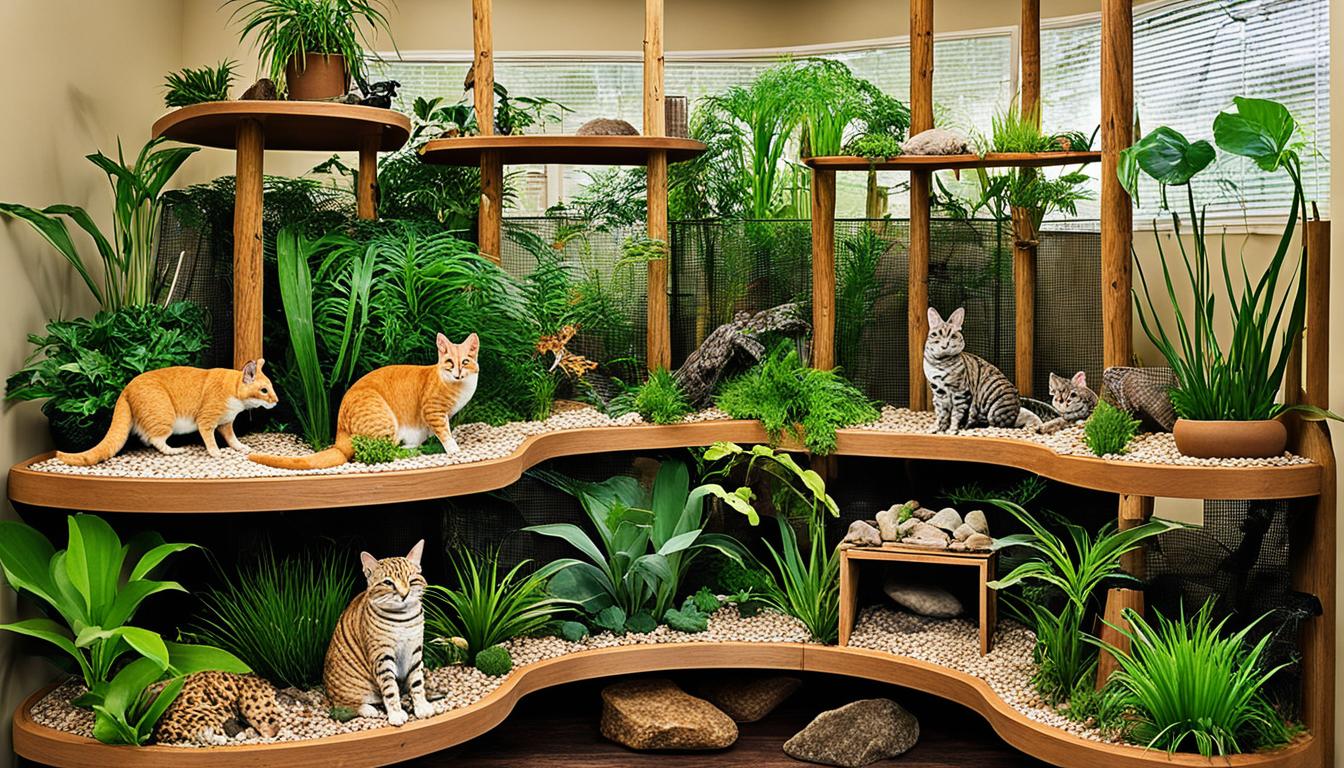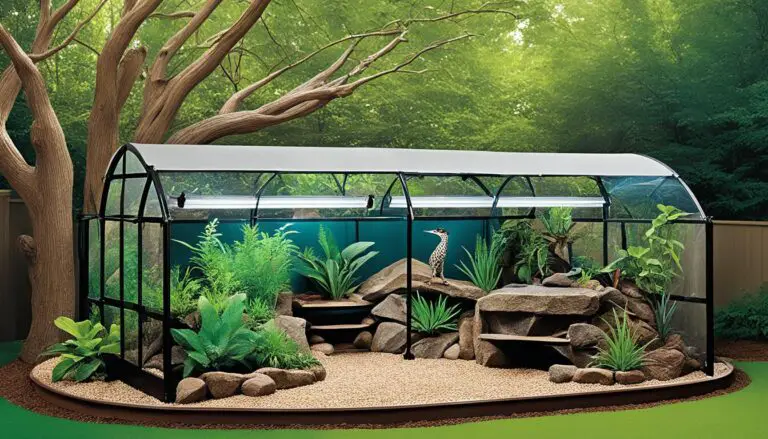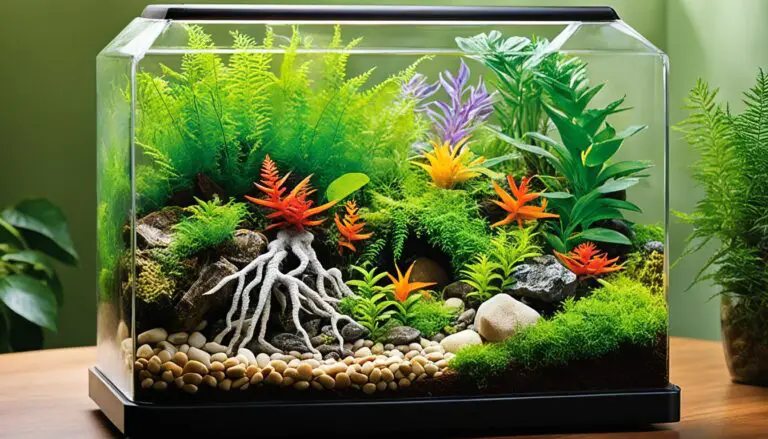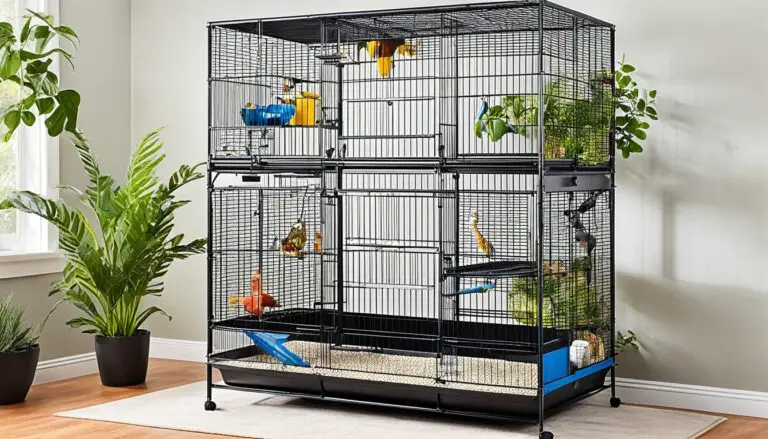Exotic Pet Housing DIY: Build Your Own Sanctuary
Want to make a cozy and stylish home for your exotic pets? We’ll show you how to build it step by step. Whether you’re caring for reptiles, birds, or small mammals, this DIY guide will help. You’ll learn how to create a perfect place for them.
Key Takeaways:
- Building your own exotic pet housing allows you to tailor the environment to meet your pets’ specific needs.
- Consider factors such as size, accessibility, and zoning laws when selecting the land for your sanctuary.
- Collaborate with other sanctuaries and animal welfare organizations to build a supportive community.
- Ensure proper medical care and nutrition for your exotic pets through established veterinary relationships and a well-balanced diet.
- Incorporate environmental enrichment activities to promote natural behaviors and overall well-being of your pets.
Understanding the Commitment and Challenges of Starting a Sanctuary
Starting an exotic pet sanctuary is a noble goal. It takes a lot of dedication to animal welfare. As the head of the sanctuary, you’ll need many skills. These include animal care and knowledge in business and legal matters.
**Starting a sanctuary** involves more than just giving animals a home. It requires **business planning**, **fundraising**, and knowledge in **legal and accounting** areas. All this helps the sanctuary thrive and continue its mission.
The challenges of running a sanctuary
Running a sanctuary isn’t easy. It includes handling the daily tasks and ensuring the animals are happy and healthy. You must comply with laws and solve problems effectively.
The **financial investment** needed to start and run a sanctuary is big. Funding is required for animal care and to keep the place up and running. This comes from donations, fundraising, and support from sponsors.
Caring for animals takes a **lot of time and effort**. Tasks include feeding, cleaning, and medical care. It takes much commitment to provide love and the best environment for the animals.
**Animal care in a sanctuary** demands knowledge of different species and their needs. This includes their homes, food, and medical care. It’s important to meet every animal’s unique needs for their happiness.
“Running a sanctuary is a labor of love and a lifelong commitment to providing a safe haven for animals in need.”
Seeking Support and Resources
There’s good news, though. Many supportive people and groups can offer help. **Working with other sanctuaries** allows for sharing advice and teaming up in fundraising.
Connecting with the community and gaining support is key. This can happen through education, volunteer programs, and local partnerships. It’s crucial to build a strong network.
By facing the challenges and seeking support, you can start this rewarding journey. You’ll make a big difference in the lives of needy exotic animals.

Key Challenges of Running an Exotic Pet Sanctuary
| Challenge | Description |
|---|---|
| Fundraising | Securing financial resources through grants, donations, and sponsorships |
| Time and Effort | Dedicating significant time and energy to animal care and facility maintenance |
| Species-specific Needs | Understanding and meeting the unique requirements of different exotic animal species |
| Regulatory Compliance | Adhering to legal and zoning regulations governing animal sanctuaries |
Getting the Business Side in Order
Before starting your adventure in animal rescue, getting your business matters straight is key. You’ll need to handle a few critical areas:
Developing a Sustainable Business Plan
Having a strong plan is a must for a lasting sanctuary. It should show your goals, and how you’ll reach them. Think about the animals, services, and how you’ll fund everything. Getting tips from pros or using sanctuary-specific guides is smart.
Understanding Fundraising Strategies
Fundraising keeps your sanctuary going and helps care for animals. Look into different ways like events, online campaigns, grants, or working with local shops. Mixing these strategies boosts your chances of getting the funds you need.
Meeting Legal Requirements
Following the law is critical when you’re housing exotic pets. Laws differ, so you’ll need the right permits, licenses, and insurance. Learn what’s required in your area by checking with experts or government bodies.
Building a Network and Volunteering
Connect with fellow sanctuary leaders for advice and friendship. Getting involved in the community teaches you much and helps others. You’ll learn a lot and might find partners for projects.
By focusing on these business essentials, you’re set to devote yourself to animal rescue. This will help your sanctuary thrive for years.
| Key Steps for Getting the Business Side in Order |
|---|
| Develop a comprehensive and sustainable business plan |
| Research and implement effective fundraising strategies |
| Ensure compliance with legal requirements and obtain necessary permits and insurance |
| Network with other sanctuary owners and consider volunteering at existing organizations |

Providing Shelter for Exotic Animals
Finding the right spot for exotic animals is key. You need land that meets specific requirements for their safety. This includes understanding zoning laws that affect where animals can live.
Land and zoning for a sanctuary are very important. Zoning laws control what you can do with the land. Knowing these laws helps you avoid trouble and create a safe place for the animals.
Choosing the right land involves several things. The size of the land must be big enough for the animals’ needs. More space means the animals can act more naturally.
Proximity to neighbors matters too. The land should be far from homes to avoid noise and smell issues. This helps keep a good relationship with those living nearby.
It’s also about location. Good transportation links are needed for supplies and vet care. Being central helps more people visit, which is good for support and adoptions.
Housing Requirements for Exotic Animals
Every exotic animal species needs a special kind of home. For example, big animals like tigers need large spaces with secure fences.
Some animals need the right temperature and humidity. Reptiles need warmth and moisture to be happy.
It’s important to think about the natural homes of these animals. Trying to copy their natural world helps them feel less stressed. Adding things like hiding places and climbing areas is good for their health.
| Species | Required Housing |
|---|---|
| Tigers | Spacious enclosures with secure fencing |
| Primates | Enriched enclosures with climbing structures and perches |
| Reptiles | Temperature and humidity-controlled habitats |
| Birds | Aviaries with ample space for flight and perching |
Always talk to animal care experts to make sure your sanctuary is the best it can be. They can help you meet high standards. This way, you give the animals great care.

Creating a safe and nice home for exotic animals is very important. By knowing about land, zoning, and what each animal needs, you can make a great place for them.
Ensuring Medical Care for Exotic Pets
Running an exotic pet sanctuary means taking care of your animals’ health. It’s key to work with vets who know exotic pets well. They help keep your sanctuary residents healthy.
Exotic animals need regular vet visits. This includes shots and health checks. A solid healthcare plan helps spot and fix health issues fast. Your animals will get the care they need.
Benefits of Spay/Neuter Programs
Spay/neuter programs are also crucial for sanctuaries. They prevent too many animals and keep the ones you have healthy.
Spaying and neutering control your sanctuary’s animal count. They also bring health and behavior perks. These procedures cut cancer risks and stop bad behaviors. Spaying and neutering mean healthier, happier animals.
Work with your vet to make a spay/neuter plan for your animals. This plan should cover surgery, aftercare, and check-ups.
Good vet care and spay/neuter programs are essential. They keep your exotic animals in top shape. These efforts also help your sanctuary thrive.

Benefits of Spaying/Neutering in a Sanctuary
| Benefits | Description |
|---|---|
| Population control | Prevents overpopulation and reduces strain on resources |
| Health advantages | Lowers the risk of some cancers and health issues |
| Behavioral improvement | Stops aggression and marking behaviors |
| Long-term well-being | Boosts overall health and life quality of sanctuary animals |
Meeting the Dietary Needs of Exotic Pets
Feeding exotic animals right is key for their health. Each animal has its own diet needs. It’s crucial to give them the right food for their well-being.
Sanctuaries can get food donations from local pet and grocery stores. These places often have extra items to give. This helps reduce feeding costs and stops waste.
Working with local food suppliers is another good idea. They know a lot about animal diets and can offer sustainable food choices. This ensures the pets get the best food.
“It’s crucial to prioritize the nutritional value of the food we provide to our exotic animals. By sourcing sustainable and high-quality food, we contribute to their overall well-being and support their long-term health.” – Dr. Amanda Rodriguez, Veterinarian
To keep diets balanced, consider protein, vitamins, minerals, and fiber. Experts in exotic animal nutrition can give advice. Combining various food sources creates nutritious meals for the animals.
It’s also important to watch the animals’ diets and health. Changes in diet may be needed based on their health. This helps keep them healthy.
Feeding Guidelines for Exotic Animals:
- Research the specific dietary needs of the exotic animal species in your sanctuary.
- Seek donations from local pet supply stores and grocery stores to reduce costs.
- Collaborate with local suppliers who specialize in sourcing sustainable and appropriate food.
- Consult with professionals experienced in exotic animal nutrition to ensure a balanced diet.
- Regularly monitor and adjust the animals’ diet based on their health and specific needs.
Following these steps helps provide a healthy diet for exotic pets. Their overall well-being benefits from the right nutrition.
Creating an Enriching Environment for Exotic Pets
Exotic animals do better when they act naturally and have fun things to do. We can make their living spaces better by making them look like their natural homes. This includes adding hiding spots, perches, and places to climb.
Toys, puzzles, and special feeding methods keep their minds and bodies active. Environmental enrichment for exotic animals helps them stay busy. It also prevents them from getting bored.
It’s important to keep their living area interesting and fun. Watching their behavior helps us see if they are stressed or unhappy. We can then give them new toys or change their living area to make them happy.
“Environmental enrichment is key for the happiness of exotic animals in sanctuaries. It allows them to behave naturally and stay mentally active. This ensures their overall well-being.”
Improving their living conditions supports their health and stops bad behaviors. Bad behaviors like pacing or hurting themselves happen when animals feel stressed or bored.
Adding new things for the animals to discover keeps their environment exciting. Promoting natural behaviors in sanctuaries is good for the animals. It also lets visitors see how animals act in the wild. This creates a stronger connection and understanding.
Examples of Environmental Enrichment for Exotic Animals
| Enrichment Type | Examples |
|---|---|
| Food-Based Enrichment | Scatter feeding, puzzle feeders, foraging opportunities |
| Structural Enrichment | Hiding spots, perches, climbing structures, platforms |
| Sensory Enrichment | Calming music, natural sounds, visual stimuli |
| Social Enrichment | Introducing compatible animal companions, group play sessions |
| Cognitive Enrichment | Puzzles, problem-solving tasks, training sessions |
Creating a good environment for exotic animals needs careful planning. We have to think about what each animal likes and needs. Keep checking to see if the fun activities are working, and change them when needed.
By focusing on environmental enrichment for exotic animals and their natural behaviors, we make a great home for them. This shows we truly care for these amazing animals.
Building a Supportive Community
Creating a supportive community is essential for an exotic pet sanctuary’s success. Working with other sanctuaries and animal welfare groups, you can form a helpful network. This network boosts your mission through shared resources and experiences.
Engage with other sanctuaries to share and learn. This could be through conferences or online forums. Here, you can meet others in your field, share ideas, and find partners.
“Collaboration is key in the sanctuary world. By working together, we can accomplish so much more for the animals we care for. Sharing our experiences, best practices, and challenges allows us to learn and grow as a community.”
– John Smith, Founder of Happy Tails Sanctuary
Animal welfare organizations are important too. Reach out to those with similar goals. They might offer funds, resources, or volunteers. Working together boosts your sanctuary’s reach and draws in supporters.
Local community involvement is crucial. Educate them on animal welfare and your work through programs and events. Invite them to volunteer. This shows the hard work needed to care for exotic animals.
Fundraising is another way to support your sanctuary. Organize events like charity runs or auctions to engage the community. These activities help raise funds and awareness for your cause.
Benefits of Collaborating and Building Community Support
The advantages of working together and gaining community support are many:
- Access to shared resources, like knowledge, expertise, and funding.
- Better visibility for your sanctuary and the issues it addresses.
- Joint efforts to advocate for exotic animal protection laws.
- Exchange of experiences and practices to improve animal care.
- More volunteers, leading to better care for the animals.
By teaming up with other sanctuaries and groups, a strong support network is formed. This helps push forward the cause of exotic pet sanctuaries. Together, we can make a difference for these animals.
Conclusion
Creating an exotic pet sanctuary takes a lot of love, hard work, and dedication. It’s all about caring deeply for animals. You’ll need good resources and a strong commitment to their welfare.
Follow this guide to make a safe and happy place for your pets. Always get advice from those who know best. And don’t forget to meet all legal needs.
Most importantly, always put the animals first. With the right plan and support, you can give them a forever home. A sanctuary can be a safe haven for exotic animals that need help.
FAQ
What should I consider before starting an exotic pet sanctuary?
What do I need to know about providing shelter for exotic animals?
How can I ensure medical care for the exotic animals in my sanctuary?
What should I know about feeding exotic animals in a sanctuary?
How can I create an enriching environment for the exotic animals in my sanctuary?
How can I build a supportive community for my exotic pet sanctuary?
How can I ensure the success of my exotic pet sanctuary?
Source Links
- https://resources.bestfriends.org/article/how-start-animal-sanctuary
- https://www.careervillage.org/questions/816731/how-would-it-be-possible-to-start-an-animal-sanctuary-for-exotic-animals
- https://www.wildcatsanctuary.org/so-you-want-to-start-your-own-sanctuary/
Peter Stones is the founder of Exotic Pets Place, the leading online resource for exotic pet care information.
With over 10 years of hands-on exotic pet ownership experience, he is deeply passionate about sharing his expertise to help others properly care for their unusual pets.
When he's not writing extensively researched articles or connecting with fellow exotic pet enthusiasts worldwide, you can find Peter at home tending to his own beloved menagerie of exotic animals.







